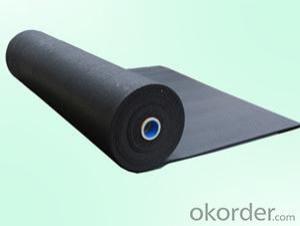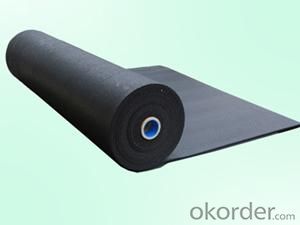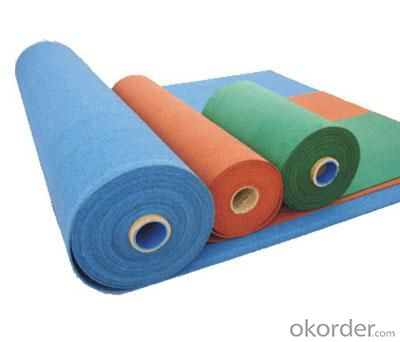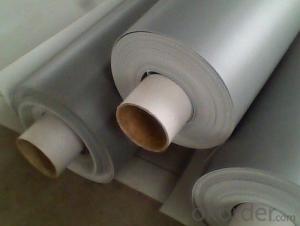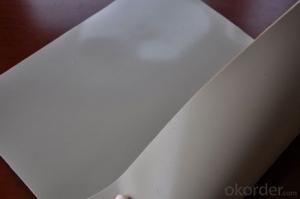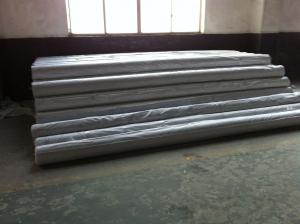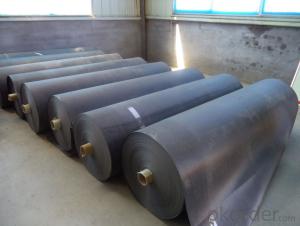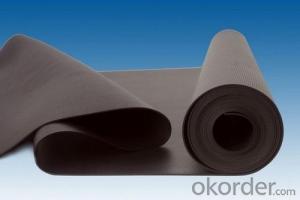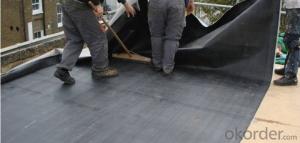EPDM waterproof membranes
- Loading Port:
- China Main Port
- Payment Terms:
- TT OR LC
- Min Order Qty:
- -
- Supply Capability:
- -
OKorder Service Pledge
OKorder Financial Service
You Might Also Like
EPDM Rubber Waterproofing membranes
Products Description
EPDM Rubber Waterproofing membranes is a synthetic rubber, synthetic tire blends as the base
material, adding reinforcing agents, softeners, antioxidants, curing agents processing aids to promote
mixing by kneading, mixing, extrusion, rolling and curing, shaping and other processes can be
processed into sheet curling volume of new high elastic waterproof material.
Products Specification
Category: Single, Compound and Reinforced
Thickness: 1.2mm 1.5mm 2.0mm
Width: 1-2m
Length: 10-50m
Physical Properties
EPDM Rubber Waterproofing membranes physical propertites
The item name | Applicable test items | ||||
(N/cm) Tension Strength (MPa) | Normal temperature≥ | 7.5 | GB6.3.2 | ||
60℃≥ | 2.3 | ||||
Elongation at break% | Normal temperature≥ | 450 | |||
-20℃ | 200 | ||||
Tear strength N | ≥ | 25 | GB6.3.3 | ||
(0.3Mpa.30 min)Water tightness | No seeage | GB6.3.4 | |||
Flexibility at low temperature ≤ | -40 | GB6.3.5 | |||
Heat expansion (mm) | Extended ≤ | 2 | GB6.3.6 | ||
Contraction ≤ | 4 | ||||
(80℃×168h) Hot air ageing | Fracture tensile strength retention %≥ | 80 | GB6.3.7 | ||
Keep rate tore elongation %≥ | 70 | ||||
Alkaline [10%Ca(OH)2 Normal temperature×168h]
| Fracture tensile strength retention %≥ | 80 | GB6.3.8 | ||
Keep rate tore elongation %≥ | 80 | ||||
(40℃×168h),200×10-8 Ozone aging | — | GB6.3.9 | |||
Artificial climate ageing | Fracture tensile strength retention %≥ | 80 | GB6.3.10 | ||
Elongation at failure rate | 70 | ||||
Bond peel strength | Standard test condition | 1.5 | GB6.3.11 | ||
Flood retention(Normal temperature×168h) %≥ | 70 | ||||
Application Range
Mainly used in all types of Industrial and civil buildings roofing, office buildings, supermarkets, steel roofing, basements,
tunnels, bridges and other impermeable, waterproof construction.

- Q: Can a waterproofing membrane be used on gypsum board surfaces?
- Yes, a waterproofing membrane can be used on gypsum board surfaces. Gypsum board, also known as drywall, is a common material used in interior construction. While it is not inherently waterproof, applying a waterproofing membrane can help protect the gypsum board from moisture damage. A waterproofing membrane is a thin layer of material that is applied to the surface of the gypsum board. It forms a barrier that prevents water from seeping into the board and causing it to deteriorate or mold. It can be used in areas where moisture is present, such as bathrooms, kitchens, laundry rooms, or basements. Before applying a waterproofing membrane, it is important to prepare the gypsum board surface properly. This may involve cleaning the surface, patching any holes or cracks, and ensuring the board is dry and free of dust. Once the surface is ready, the waterproofing membrane can be applied according to the manufacturer's instructions. It is worth noting that while a waterproofing membrane can provide some protection against moisture, it is not a guarantee against water damage. It is always important to address the source of water intrusion and ensure proper drainage and ventilation in any area prone to moisture. Additionally, it is recommended to consult with a professional or follow the manufacturer's recommendations when choosing and applying a waterproofing membrane to gypsum board surfaces.
- Q: Can a waterproofing membrane be used on flat roofs?
- Yes, a waterproofing membrane can be used on flat roofs. In fact, it is a common and effective method used to protect flat roofs from water damage and leakage. The waterproofing membrane is designed to provide a durable and watertight barrier, ensuring the roof remains protected from rain, snow, and other elements.
- Q: Does a waterproofing membrane require a primer before application?
- In order to apply a waterproofing membrane, it is necessary to use a primer. The purpose of a primer is to improve the adhesion between the membrane and the substrate, guaranteeing a strong bond. Additionally, it acts as a sealant that protects the surface, preventing any moisture or impurities from affecting the efficiency of the waterproofing system. For a reliable and enduring waterproofing solution, it is crucial to apply a primer prior to the membrane.
- Q: Can a waterproofing membrane be used on metal block surfaces?
- Metal block surfaces can indeed benefit from the use of a waterproofing membrane. These membranes are specifically designed to form a barrier against water and moisture, and they are versatile enough to be applied to various types of surfaces, including metal. By adhering to the metal surface, the membrane creates a protective layer that not only prevents water infiltration but also safeguards the metal against rust and corrosion. However, it is crucial to guarantee that the metal surface is thoroughly cleaned, dried, and appropriately prepared before the application of the waterproofing membrane. This preparation ensures optimal adhesion and effectiveness. For specific instructions on using a waterproofing membrane on metal block surfaces, it is highly recommended to consult a professional or refer to the manufacturer's guidelines.
- Q: Can a waterproofing membrane be used for potable water tanks?
- Using a waterproofing membrane for potable water tanks is not recommended. Although a waterproofing membrane is effective in preventing water penetration and protecting surfaces from moisture damage, it is not suitable for guaranteeing the safety and purity of potable water. To ensure the safety of the water, materials specifically designed and approved for water storage, such as food-grade coatings or liners, should be used for potable water tanks. These materials are formulated to prevent any leaching or contamination of the water, thus ensuring its suitability for consumption. Hence, it is crucial to adhere to industry standards and regulations and utilize appropriate materials when constructing potable water tanks.
- Q: How does a waterproofing membrane adhere to the surface?
- A waterproofing membrane adheres to the surface through various methods such as mechanical attachment, adhesive bonding, or heat welding. Mechanical attachment involves physically securing the membrane to the surface using fasteners, nails, or screws. Adhesive bonding utilizes a waterproofing adhesive to create a strong bond between the membrane and the surface. Heat welding involves melting the membrane's surface and fusing it with the substrate, creating a watertight seal. The specific method used depends on the type of membrane and the surface to which it is being applied.
- Q: Can a waterproofing membrane be applied on top of insulation materials?
- Yes, a waterproofing membrane can be applied on top of insulation materials. In fact, it is often recommended to install a waterproofing membrane over insulation materials to provide an added layer of protection against moisture infiltration. This is especially important in areas where water damage is a concern, such as basements or areas prone to heavy rainfall. The waterproofing membrane helps to prevent water from seeping into the insulation and causing damage or reducing its effectiveness. Additionally, the membrane acts as a barrier, preventing water vapor from penetrating the insulation and potentially leading to condensation or mold growth. However, it is important to ensure that the insulation materials are properly installed and that any necessary air gaps or drainage systems are in place to prevent water from becoming trapped between the membrane and the insulation.
- Q: Can a waterproofing membrane be used on precast insulation surfaces?
- Yes, a waterproofing membrane can be used on precast insulation surfaces. The membrane acts as a protective barrier, preventing water penetration and ensuring the insulation remains dry and functional.
- Q: Can waterproofing membranes be used on bridge decks?
- Yes, waterproofing membranes can be used on bridge decks. Bridge decks are constantly exposed to harsh weather conditions, including rain, snow, and freeze-thaw cycles, which can lead to the deterioration of the concrete and steel reinforcement. Waterproofing membranes are designed to prevent water infiltration and protect the bridge deck from moisture-related damage. These membranes are typically made of flexible materials such as bitumen, PVC, or EPDM rubber, and they are applied directly onto the bridge deck surface. The waterproofing membrane acts as a barrier, preventing water from seeping into the concrete and causing corrosion of the reinforcement. It also helps to reduce the formation of cracks and extends the service life of the bridge deck. Additionally, waterproofing membranes can be combined with other protective coatings or systems to enhance their effectiveness and durability. Overall, the use of waterproofing membranes on bridge decks is a common and effective method to ensure the long-term integrity and functionality of the structure.
- Q: Can a waterproofing membrane be used on both interior and exterior walls?
- Yes, a waterproofing membrane can be used on both interior and exterior walls. The membrane helps prevent water penetration, providing protection against moisture for both sides of the wall.
Send your message to us
EPDM waterproof membranes
- Loading Port:
- China Main Port
- Payment Terms:
- TT OR LC
- Min Order Qty:
- -
- Supply Capability:
- -
OKorder Service Pledge
OKorder Financial Service
Similar products
Hot products
Hot Searches
Related keywords
